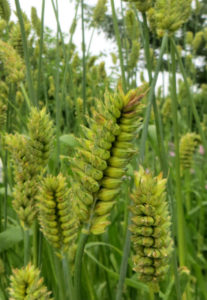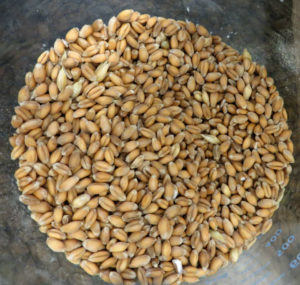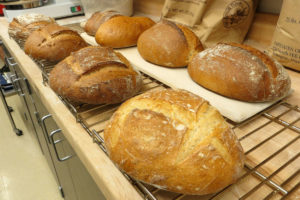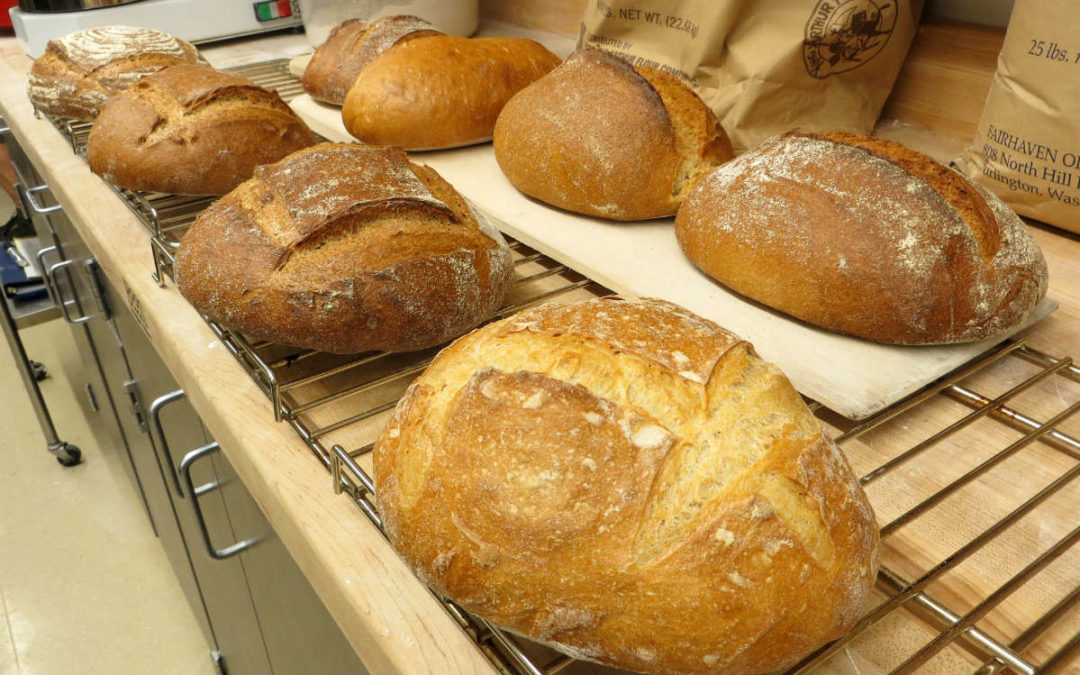
Wheat growing at the Munich Botanical Garden
Bread eaten as a sandwich, croutons in a salad, crumbs encasing a chicken leg, or slathered with pizza sauce. Bread is ubiquitous. Most Americans just eat bread with no thought of how it got to their plate. Someone has to grow, pick, clean, process, package, ship, and display each slice of bread we eat. Coming out of the 1960’s back to the land movement, food pioneers began to speak out about the system that provides our bread. Most of America was eating white, fortified, mass-produced, purified, plastic-wrapped bread. The early Foodies knew we were missing the benefits of whole grain and realized our agricultural system was becoming industrialized and centralized. Recently more eaters are becoming motivated to understand where our food really comes from.
In Aaron Bobrow-Strain’s White Bread–A Social History of the Store-Bought Loaf, the bread industry’s consolidation and concentration phenomena is extensively researched and exposed some of my favorite bread products such as Boboli pizza, Thomas’ English Muffins and Oroweat as owned by the Mexican conglomerate Bimbo. I am not against buying food from a foreign national company, I just like to know it when I do and where it comes from.
Wade’s Wheat

Raw wheat kernels
Bread companies being run by a distant owner can create homogeneous loaves, as Wade Troutman, a 4th generation farmer growing wheat, canola and other small grains on 5,000 acres of owned and leased land near Bridgeport, Washington knows. Prior to meeting Jeff Weissman, the former owner of the Lake Forest Park Great Harvest Bakery, Wade was selling all of his wheat to the commodity market, which shipped it to China to be processed and returned it to the United States for industrialized bread production. Wade had never eaten the product from his fields. Jeff changed this and made Wade’s Wheat special, by grinding it in his stone mill and selling the premium bread product to his loyal customers. I remember the day I met Wade and he told me the story when he tasted his first slice from his home-grown wheat. He was so happy, he cried. Selling wheat directly to the baker, with no middleman taking a cut, allowed Wade to savor his livelihood and to have a secure retirement when that day comes.
Jeff no longer owns the bakery, but rather than returning to the commercial market, Wade now sells his wheat to the Fairhaven Mill in Burlington, Washington, a family owned specialty grain miller. Three years ago, ten percent of Fairhaven’s grains were from Washington and now 60% are Washington-grown products.
Skagit County Wheat
On Cinco de Mayo, I was fortunate to spend the day touring the Washington State University (WSU), Mount Vernon, Washington bread lab at an event sponsored by Washington Sustainable Food and Farming Network, more commonly known as The Network which brought members and guests together to reconnect with our sustenance. Our host Dr. Stephen Jones has been conducting wheat variety experiments since 1991, as has been done at WSU since 1894. Dr. Jones does not focus on product from “The Wheat State,” more commonly known as Kansas, but on select strains of the 162 different wheat varieties that were grown from Sequim to the Palouse across Washington State between 1840 and 1950. A Red Russian variety currently being trialed on Whidbey Island in Puget Sound shows promise by generating 119 bushels per acre, which is more than double the average 45 bushels per acre found on Kansas farms.

Test bread loaves in the Washington State University bread lab
The quantity grown is not the only attribute being tested in these wheat trials. The quality and terroir is also being rediscovered by growing wheat in places that it has not been grown for 50 years. Of the 80,000 acres of fertile Skagit County farmland located about an hours drive north of Seattle, currently 15,000 acres are in wheat production–re-establishing the terroir or a sense of place. Scott Mangold, owner of the Breadfarm, a small artisan bakery in the Skagit Valley can “pick up chocolaty overtones and a hint of spice in the bread” grown on the outskirts of LaConner on Hedlin Farms.
Dr. Jones created multiple loaves from choice local grains for us to savor while we enjoyed a potluck lunch amongst the flowering springtime beauty.
Recreating the Food System
This foray into understanding where my bread comes from has deepened my understanding of how broken our food system really is. No longer do we know from whence our food comes from, unless we make a point of knowing that fact.
I support The Network because I know it is doing the work to recreate and reinvigorate a regional and local food economy that is prosperous, ecologically sound and socially equitable. I do want to know where my food comes from and how it is grown. Will you take the leap into knowing where your food comes from, too?
Kathryn Gardow, P.E., is a local food advocate, land use expert and owner of Gardow Consulting, LLC, an organization dedicated to providing multidisciplinary solutions to building sustainable communities. Kathryn has expertise in project management, planning, and civil engineering, with an emphasis on creating communities that include food production. Kathryn is a Washington Sustainable Food and Farming Network board member. Kathryn’s blog muses on ways to create a more sustainable world.


I enjoyed munching and savoring you bread notes! I recall fondly meeting Jeff — and regret that I never took him up on his sincere offer to have me come and share a shift at his bakery…I’m a bakery junkie…used to go do that whenever I could visit The Eugene City Bakery — goldie